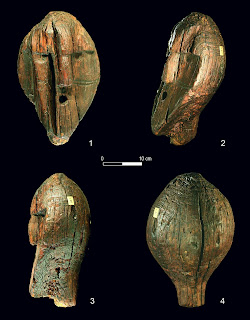Göbeklitepe, Karahan Tepe, Nevalı Çori and a number of other prehistoric ritual sites across southwest Turkey and northern Syria have attracted more than their fair share of wild theories in recent years, mostly because they seem so out of place in a period - the Pre-Pottery Neolithic - which was all about small-scale farming, gathering and staying local. Among the most out-there ideas are that their characteristic T-pillars represent alien overlords or celestial figures inspired by visitors from outer space. The importance of the sites has also made comparisons to the legends of the Annanuki, the Sumerian creator-gods, and the Biblical Garden of Eden, inevitable. A similarly far-fetched theory, however, has recently come from senior academics in the field.
Semih Güneri, a retired professor from Dokuz Eylul University, has claimed on the basis of similar stone tools and genetic evidence that there was a massive, long-distance migration from Siberia to the Zagros Mountains starting around 30,000 BCE, which had a knock-on effect on Anatolia, where Siberian lithic technology was introduced. These were mostly microblades, some just 2-5 millimetres in length, presumably used for cutting up cloth as well as for hunting. This population transfer is apparently documented by the genetic closeness between pre-Pottery Zagros hunter-gatherers and Siberian late Palaeolithic hunters. As it's been hinted that Iranian hunter-gatherers took to farming first and moved to introduce farming to Anatolia, it's easy to see how Siberian culture could have arrived there. Since the time between 30,000 and 10,000 BCE is rather vast, this was probably a multi-stage, gradual movement, but one that left a substantial movement.
Some of what Güneri claims, however has undertones of Pan-Turkism, an ideology that essential claims that ancient Turks throughout prehistory and history disseminated culture from the north wherever they went - his argument was presented in a workshop literally called 'Proto-Turks Bearing Culture to the World'. It seems a bit of a stretch to pin a modern ethno-linguistic identity to a Paleolithic social group, who likely spoke a variety of verbal and non-verbal languages. He also appears to overlook the possibility that similar microblades might have been invented independently. All of this would leave his hypothesis on shaky ground; however, there are other hints that a migration, movement or contact of some kind did occur between southwest Turkey and Siberia, after the heyday of Gobekli Tepe.
In the modern Altai Republic wedged between the borders of Kazakhstan and Mongolia, a number of probably Bronze Age petroglyphs, depicting 'fantastic beasts' have been found which look very like the animal reliefs on the pillars of Gobeklitepe. These are found on cliff faces, and have been assigned as works produced by the communities of the Okunev culture, which was ultimately descended from Indo-European speaking pastoralists of the Afanasievo culture in the 4th millenium BCE. This is not in itself proof of anything, but it might bear witness to a mythology shared among hunter-gatherers from southwest Asia to northeast Siberia, arisen from contact dating back to the Stone Age.
A more direct piece of the puzzle is the Shigir Idol, from the Ural Mountains. Radiocarbon-dated to 10,200 BCE, the haunting, gangly wooden statue is incised with geometric patterns and a schematic face, and was found alongside antlers carved with animal faces and a scattering of lithics. It had puzzled archaeoogists for decades until the images at Gobekli and Karahan Tepe were brought to light. The formless, shut-eyed and pinched-mouth face is almost identical in style to a carved head at one of the enclosures at Karahan Tepe, among other examples. The idol also has four other carved faces on its limbs, which is comparable to the animal faces on different sides of the more anthropomorphic T-pillars. It would make sense that the Tepe carvings are a manifestation in stone of an older and more widespread carving tradition in wood, just as wooden henges predeceded or accompanies many stone circles. The smaller antler carvings are also a jumble of pig, wolf and dog features, representing a fantasy animal in the same way as the strange lizard and bird mishmashes at the Tepe enclosures.
The Shigir Idol also might be a very old ancestor of more modern Mansy wooden-pole totens, carved with similar faces to ward off evil spirits and aid shamanic ceremonies. In terms of general form, carved sculptures are found across periods in the Russian and Mongolian forest-steppe, such as the spooky Yamnaya stelae and the figurines of the Samus culture. The T-shaped combination of the raised forehead and nasal ridge is also found in anthropomrophoc representations on spears, ingots, axes and mobile art in Siberia from the 2nd to the 1st millenium BCE.
In sum, what there is evidence for is a contemporaneous, similar artistic tradition in southwest Anatolia and central Siberia, which may have continued in the latter up until the later Bronze Age. What is not there is a massive, proto-Turkic demographic arrival from the north, although the fact that only around Shigir and around the Altai Republic similar art is found makes it possible that the two Siberian regions had a direct relationship with the Göbeklitepe landscape.
There may be a very heavy survival bias distorting the data; the Shigir idol was only recovered by chance, during quarrying, and there are many Tepe sites still waiting to be excavated.
References:
https://arkeonews.net/the-migration-movement-that-started-from-siberia-30000-years-ago-may-have-shaped-gobeklitepe/
Bobrov, V. (2021). Shigir idol: Origin of monumental sculpture and ideas about the ways of preservation of the representational tradition. Quaternary International, 573, 38-48.
Zhilin, M., Savchenko, S., Hansen, S., Heussner, K., & Terberger, T. (2018). Early art in the Urals: New research on the wooden sculpture from Shigir. Antiquity, 92(362), 334-350. doi:10.15184/aqy.2018.48


Comments
Post a Comment